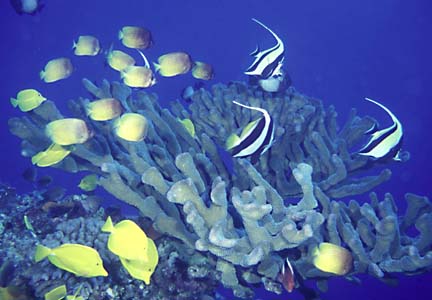
Locals and tourists alike are drawn to the abundant marine life in Hawaii's coral reefs. Robert Schraedley snorkeled Sunday near a green sea turtle off Kauai's North Shore.
The state and counties prepare
a campaign to protect island reefs» Eco-etiquette for reef relief » Protecting Hawaii's reefs
Coral reefs make the waves break at Hawaii's famous surf spots.
They are home to thousands of reef fish and other sea animals.
And even when Hawaii's reefs are dead, their fragments make sand for beaches.
"We surf, we fish, we swim, we kayak, we snorkel, we canoe. I think (in) Hawaii, more than any other place in the U.S., we utilize the ocean a lot, and it means a lot to us," says Alan Friedlander, a fish scientist with the National Oceanic and Atmospheric Administration. "It's our food, our recreation, our culture."
Yet "most people are oblivious to coral reefs," notes Wendy Wiltse, a Hawaii-based scientist with the Environmental Protection Agency. "Because they're underwater, it's like they're invisible. People don't have any perspective on how incredibly special, productive and rich the reefs are."
Gov. Linda Lingle and county mayors plan to kick off a year-long public information campaign tomorrow called "A Living Reef Gives Our Islands Life." A Web site (www.hawaiireef.org) will link to information about Hawaii's reefs, including lists of public events where people can learn more about Hawaii's reefs and the threats they face -- and volunteer to help them.
More than 40 government, community and scientific groups are backing the effort under the umbrella of the Hawaii Coral Reef Outreach Network.
Hawaii's reefs are home to more than 5,000 species of marine plants and animals. One in four is found only in Hawaii.
Antler coral (Pocillopora eydouxi) is shown with various species of fish in a photo taken this month outside Molokini Crater at a depth of about 60 feet.
A recent study pegged the economic value of Hawaii's reefs at $364 million a year.
That's a conservative estimate, says Mike Hamnett, director of the Hawaii Coral Reef Initiative Research Program, which awards grants to scientists for coral reef research.
It counts the money people spend on snorkeling and scuba diving but not their hotel rooms or other expenses, he says. It counts an added value for property near reefs but doesn't attempt to quantify the overall value of the reefs to the state. And it doesn't even begin to speculate about the potential value of medicines or other potential products from the reef.
"It's kind of like that MasterCard commercial," Hamnett says. "How much is fishing and snorkeling and teaching your kids and grandkids how an ecosystem works? Priceless."
Though the exact percentage is undergoing an update by the National Oceanic and Atmospheric Administration, it's still a sure bet that Hawaii is home to more than half the coral reefs in U.S. territories.
Hundreds of scientists and graduate students are studying Hawaii's coral reefs and the fish and other creatures that live in them.
Coral reef research topics range from what makes corals "bleach" to the effects on coral ecosystems of pollution or overfishing.
In the past five years, more than $12 million has targeted coral reef research, management or mapping, says Athline Clark, of the state Division of Aquatic Resources.
That's good, but it's time to protect as well as study, says coral reef ecologist David Gulko, also of the Division of Aquatic Resources.
Despite the obvious connection between healthy coral reefs and healthy tourism, recreational fishing and conservation, just 13 percent of the coral reef in the main Hawaiian islands is designated as a preservation area. Land-based conservation programs seem to be more likely to protect the resource, even as it is studied, Gulko says.
"There are coral colonies in Hawaii that are close to 1,000 years old, and they are alive," he says.
In Hawaii the state of the reefs is a good news-bad news equation.
The Northwestern Hawaiian Islands have among the most unspoiled reefs in the world. In the main Hawaiian islands, where all the people live, it's a different story.
The most significant threats to Hawaii's coral reefs are man-made: overfishing, land-based pollution, invasive algae and recreational overuse.
Kim Peyton, a University of Hawaii graduate student who has recently dived in the remote Northwestern Islands, puts it this way: "If the Northwestern Hawaiian Islands are a '10' (on a scale of one to 10), the main islands are a '5.'"
Here is a brief overview of the major threats:
>> Overfishing: Records show that in 1900, Hawaii fishermen sold 3.5 million pounds a year of reef fish, but by 1950 the catch had dropped to less than 1 million pounds a year. The yield of reef fish has been sinking ever since.One reason is that many reef fish are being caught as juveniles, before they reproduce and can perpetuate their species, says NOAA's Friedlander.
Among other options to increase the quantity of reef fish is the possibility of more areas off-limits to fishing to act as nurseries for new generations. It is scientifically proven to be effective but is generally not popular with fishermen who stand to lose a favorite spot, Friedlander said.
>> Land-based pollution: Some of the fertilizer applied to golf courses and home lawns washes into the ocean and is a main suspect in making seaweeds "bloom" out of proportion.
The ill effects of other pollution that comes off our streets and parking lots is difficult to track, but it's there. Seepage from cesspools or injection wells and spills from sewage systems cause a loss of oxygen in the water that can kill fish and harm the environment.
>> Alien algae: Just offshore from the Waikiki Aquarium, an invasive algae nicknamed "gorilla ogo" has pushed aside native limu and altered the ecology of the coral reef in the Waikiki Marine Life Conservation District.
Though volunteers have held a dozen cleanups there over the past two years, it is going to keep coming back unless more intensive measures are adopted, says University of Hawaii botanist Celia Smith.
"Twenty years ago, Sans Souci would have seen 65 to 80 species of native algae," Smith says. "Now you see Gracilaria salicornia (gorilla ogo) occurs from shore to reef crest."
>> Recreational overuse: Hanauma Bay might be the best-known example of a place that was almost "loved to death" by nature enthusiasts. Nine trampling incidents by an average-size adult are enough to kill a coral, according to a study by UH researcher Paul Jokiel. Even a touch could be harmful, since human hands have oils that could damage the living coral tissues.
BACK TO TOP |
Eco-etiquette for reef relief
What you can do to help save Hawaii's coral reefs:
Stop alien species
>> Clean boat hulls regularly.>> Get involved in volunteer cleanups.
Fish smart
>> Take only what you need and stick to official limits.>> Do not leave fishing equipment, including lines and nets, on the reef.
Be an informed aquarium hobbyist
>> Do not take live coral from the ocean.>> Purchase only common species.
>> Do not dump aquarium water into the ocean.
Do not touch the coral
>> Avoid interfering with coral reefs in any way.>> Wear floatation devices when snorkeling, and stay clear of corals while swimming.
Operate boats responsibly
>> Do not drop anchors on coral reefs; look for sandy bottoms instead.>> Use moorings instead of anchoring.
Divers and snorkelers
>> Minimize stirring sediment.>> Always leave marine life alone; do not touch or pull out of water.


